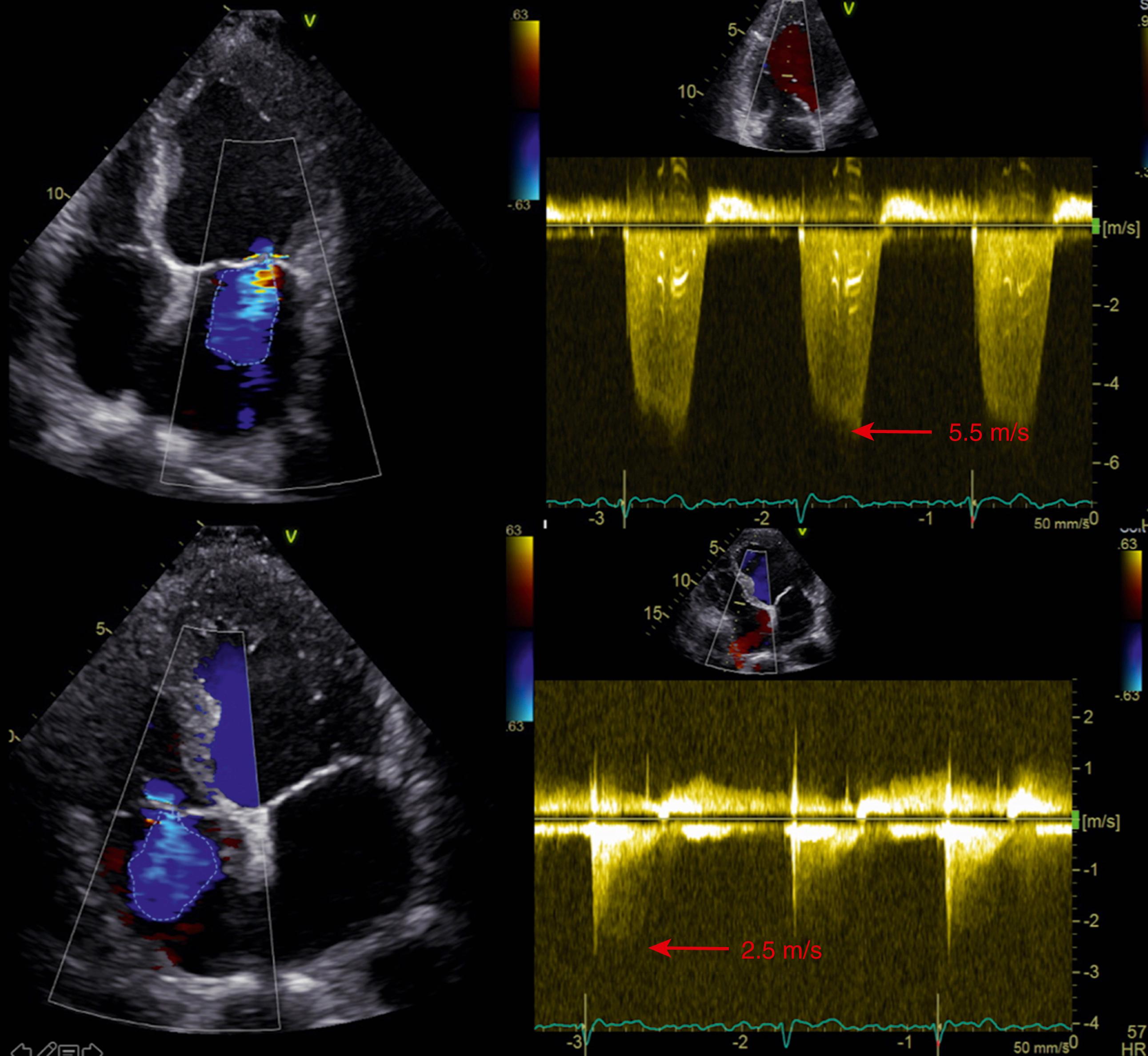Physical Address
304 North Cardinal St.
Dorchester Center, MA 02124
Two- and three-dimensional echocardiography (2DE and 3DE, respectively), combined with spectral and color-flow Doppler evaluation, provides the most accurate laboratory test in detection and quantification of tricuspid regurgitation (TR). “Physiologic” TR is associated with normal valve leaflet morphology and normal right ventricular and atrial size ( Fig. 103.1 ). When “pathologic” TR is suspected on color Doppler, a complete understanding of leaflet morphology and of the pathophysiological mechanisms underlying TR is mandatory (see Chapter 101 ). In these cases, a more comprehensive assessment of the morphology of the tricuspid valve (TV) apparatus using transthoracic 2DE and 3DE (see Chapter 101 ) provides important clues on the underlying etiology and mechanisms of TV dysfunction.
Current guidelines recommend a multiparametric approach to assess the severity of TR ( Table 103.1 ), taking into account qualitative, semiquantitative, and quantitative parameters. Even though the echo Doppler parameters used to assess TR are the same used to assess left-sided valve regurgitation, several critical factors should be taken into account when using them to grade the severity of TR. The most important ones are (1) the anatomic differences between the TV (three-leaflet) and the mitral valve (two-leaflet); (2) except in patients with severe pulmonary hypertension, the TR jet has lower velocity and lower pressure than the mitral one; and (3) the severity of TR varies during the respiratory cycle.
| Parameter | Mild | Moderate | Severe |
|---|---|---|---|
| Right Heart Structures | |||
| TV leaflets | Normal or mildly abnormal | Moderately abnormal | Flail leaflets, severe tethering or retraction with large coaptation defect, perforation |
| RV and RA size | Usually normal | Normal or mild dilatation | Usually dilated |
| Inferior vena cava | Normal (<2 cm) | Normal or mildly dilated (2.1–2.5 cm) | Usually dilated |
| Qualitative Doppler | |||
| Color flow jet area a | Small, narrow, central | Moderate central | Large central or eccentric wall-impinging jet of variable size |
| Flow convergence zone | Not visible, transient or small | Intermediate in size and duration | Large throughout systole |
| Continuous-wave Doppler spectral tracing | Faint, incomplete, parabolic | Dense, parabolic or triangular | Dense, often triangular with early peaking |
| Semiquantitative Doppler | |||
| Color-flow jet area (cm 2 ) b | Not defined | Not defined | >10 |
| VC width (cm) b | <0.3 | 0.3–0.69 | ≥7 |
| PISA radius (cm) c | ≤0.5 | 0.6–0.9 | ≥1 |
| Hepatic vein flow d | Systolic dominance | Systolic blunting | Systolic flow reversal |
| Tricuspid inflow d | A-wave dominant | Variable | E-wave >1 m/s |
| Quantitative Doppler | |||
| EROA (cm 2 ) | <0.2 | 0.2–0.39 e | ≥0.4 |
| Regurgitant volume (mL) | <30 | 30–44 e | ≥45 |
| Regurgitant fraction (%) | Not defined | Not defined | Not defined |
a Right ventricular (RV) and atrial (RA) size can be within the “normal” range in patients with acute severe tricuspid regurgitation.
b With Nyquist limit >50 to 70 cm/s.
c With baseline Nyquist limit shift of 28 cm/s.
d Signs are nonspecific and are influenced by many other factors (RV diastolic function, atrial fibrillation, RA pressure).
e There are few data to support further separation of these values.
When looking at the color jet area to estimate the severity of a regurgitant jet, we need to take into account that the color jet area is not related to regurgitant volume, but it is determined by conservation of jet momentum (roughly defined as flow × velocity or Q × v) and technical factors ( Box 103.1 ). Accordingly, the same color jet area can be seen for completely different regurgitant orifice areas (EROA) and volumes ( Fig. 103.2 ). Because flow (Q) = EROA × v and momentum (M) = Q × v or EROA × v 2 , it is clear that, for the same EROA, a 6-m/s mitral regurgitant jet will create a jet area that is four times larger than a 3-m/s TR jet.
Gain
Scale
Frame rate
Transducer
Color-flow algorithms
Ultrasound machine

In addition to jet momentum, several instrument settings affect the jet size by color Doppler; the most important among them is the color scale (see Chapters 88 and 98). Finally, the displayed jet size is also affected by constraint of the right atrium (RA) and the direction of the jet. Eccentric jets, directed against the RA wall, are, on average, 75% smaller that central jets of similar severity that are free to expand in the RA cavity.
Accordingly, when assessing TR color Doppler jets to estimate the severity of TR, some key points should be taken into consideration: (1) the color Doppler jet area depends on jet momentum, which is lower for TR than for mitral regurgitation (MR); (2) reducing the color scale enlarges the color jet area; and (3) usually, the severity of TR is overestimated with centrally directed jets and underestimated with eccentric jets that run along the RA wall.
The jet-to-RA area ratio is another commonly reported parameter to estimate the severity of TR. However, RA size increases with the severity of TR, and particularly in patients with atrial fibrillation, enlargement of RA size itself is involved in the pathophysiology of TR. , , Therefore, using a fixed jet-to-RA area ratio threshold value would lead to underestimation of the severity of TR with progressive enlargement of the RA.
Become a Clinical Tree membership for Full access and enjoy Unlimited articles
If you are a member. Log in here